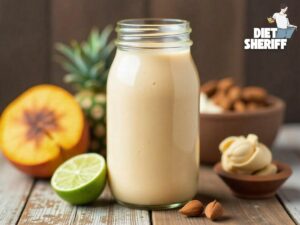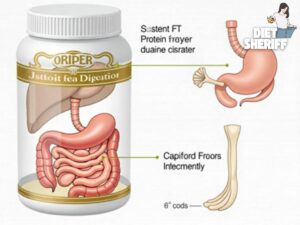In order to optimize muscle growth and recovery, protein powder has emerged as a necessary supplement.
It is an effective way to get high-quality protein, supporting the body’s muscle protein production. Nevertheless “How to use protein powder to build muscle?” is the most important question.
It’s important to know the best times and ways to consume protein powder to build muscle.

Why is Protein Powder Considered Essential for Muscle Growth and Recovery?
Protein powder is frequently seen as necessary for both muscle development and recovery, because of a number of important factors:
Related Article: Can You Put Protein Powder in Yogurt? A Complete Guide
The Role of Protein in Muscle Growth and Repair
- Muscle Protein Synthesis:
The building blocks of muscle tissue are amino acids, which are also the building blocks of proteins.
The body grows more muscle as a result of the synthesis of new muscle proteins to heal the damage.
- Amino Acids:
In order to boost the synthesis of muscle protein, certain amino acids are essential.
These amino acids are easily obtained from protein powder.
Quick Access and Effectiveness
- Simple and Quick:
You may easily incorporate protein powder with water. It is therefore a practical choice for a post-workout snack.
- Digestibility:
The body readily absorbs a lot of protein powders, particularly whey.
Muscles can get amino acids more quickly due to this than from whole dietary proteins.
https://gigasecurehome.com/ring-doorbell-2-not-spinning-white
Related Article: Best Protein Powder for Lactose Intolerance: Top Choices Reviewed
Regular Intake of Protein
- Meeting Protein Requirements:
The demand for protein is higher among athletes and others who engage in frequent physical exercise.
Protein powders make sure these people get the necessary amount of protein each day.
- Supplementing Diet:
Protein powder might help people who might find it difficult to obtain adequate protein from their daily diet.
Profile of Nutrition
- Low in Fat and Carbs:
A lot of protein powders are made with less carbohydrates and fats in mind.
They are a useful strategy for boosting protein consumption without dramatically increasing the number of calories from other macronutrients.
- Fortification:
Certain protein powders have extra vitamins and minerals added to them to help with recovery and general nutrition.
Related Article: Whey Protein vs Casein for Muscle Gain: What Should You Choose?
https://gigasecurehome.com/do-ring-doorbell-record-cars-driving-by
Enhanced Muscle Recovery
- Reduced Muscle Soreness:
After working out, consuming protein can help minimize pain in the muscles and increase healing.
- Immune Support:
The immune system may become momentarily weakened by intense exercise.
Consuming protein supports immunological function and promotes general healing.
Cost Effectiveness
- Affordable Protein Source:
Protein powders can be an affordable option for boosting protein taken by taking into account the cost per gram of protein.
When considering entire food sources, protein powder is preferable, especially when it comes to premium animal proteins.
Enhanced Metabolic Rate
- Thermic Effect of Food:
Thermic impact of protein is greater than that of fats and carbohydrates.
Consuming protein on a regular basis might support total energy expenditure by increasing the metabolic rate.
https://gigasecurehome.com/blink-camera-detects-motion-but-not-recording
What is the Effective Ways to Incorporate Protein Powder into a Muscle Building Diet?
There are a number of efficient ways to include protein powder in a diet that builds muscle. It is essential to know, how to use protein powder to build muscle.
Here’s an in-depth instruction on how to do this:
Related Article: Organic Protein Shake Benefits: Why Go Organic for Your Nutrition?
Post-Workout Shakes
Purpose
Replenishes amino acids quickly and helps in muscle development as well as repair right after activity.
Preparation
- Protein Shake:
- Add a scoop of protein powder to a glass of milk, or use water as a substitute for milk.
- For extra nutrition, include items like spinach, oats, berries, and bananas.
Protein Shake Recipe for Example
- One scoop of whey protein
- One banana
- one cup of spinach
- One cup almond milk
- One tablespoon of chia seeds
- Blend till it smooth.
Breakfast Boosts
Purpose
To support muscular maintenance and energy levels, start your day with a meal high in protein.
Preparation
- Oatmeal:
- Cooked oats are mixed with a scoop of protein powder.
- Add more taste and nutrition by adding fruits, nuts, or seeds.
- Pancake:
- Stir some protein powder into the batter for the pancakes.
- This gives you extra protein and makes a nutritious, muscle-building breakfast.
Pancake Recipe Example
- One scoop of protein powder with vanilla flavor
- One cup of rolled oats
- One banana
- Two eggs
- One tablespoon of baking powder
- Cook on a nonstick skillet after blending all ingredients.
Protein-Enhanced Snacks
Purpose
Consume protein periodically throughout the day to avoid muscle breakdown and increase muscle recovery.
Preparation
- Protein Bars:
- Blend protein powder, nut butter, honey, and oats to make your own protein bars.
- It guarantees a convenient and healthful snack choice.
- Yogurt:
- Incorporate a serving of protein powder into Greek yogurt.
- Sprinkle almonds, granola, or fruits over top.
- Smoothies:
- A healthy snack may be made by blending protein powder with drinks, fruits, and veggies.
Smoothie Recipe Example
- A single scoop of protein powder
- One cup of mixed frozen berries
- One cup of spinach
- One cup of coconut water.
- Mix until homogenized.
Baking with Protein Powder
Purpose
Use tasty baked goods as a way to increase your intake of protein. Consuming enough protein becomes simpler as a result.
Preparation
- Muffins and Cookies:
- Mix protein powder into cookie as well muffin recipes.
- Enjoying sweets without sacrificing your muscle-building objectives is possible with this method.
Protein Muffin Recipe for Example
- One scoop of protein powder
- One cup of flour made from almonds
- One-half cup of mashed bananas
- Two eggs
- One tablespoon of baking powder
- Blend all components together and bake for 20 to 25 minutes at 350°F (175°C).
Protein-Infused Main Meals
Purpose
Make sure your primary meals contain a significant amount of your daily protein consumption.
Preparation
- Soups and Stews:
- Add protein powder to stews and soups. Savory foods are the ideal use for flavorless protein powders.
- Casseroles:
- Add protein powder to baked goods especially casseroles.
Protein Soup Recipe for Example
- One scoop of flavorless protein powder
- One cup of finely chopped chicken breast
- One cup of mixed veggies and two cups of chicken broth
- When the veggies are soft, add the protein powder and mix.
Protein-Rich Desserts
Purpose
Fulfill your sweet need while increasing your protein intake by helping your muscles strengthen.
Preparation
- Protein Ice Cream:
- Protein powder, frozen bananas, and a little amount of milk can be blended to make a nutritious substitute for ice cream.
- Puddings:
- Put protein powder to Greek yogurt as well chia pudding desserts.
Protein Pudding Recipe for Example
- One scoop of protein powder with chocolate flavor
- One cup almond milk
- Two tablespoons of chia seeds
- After combining, refrigerate for the entire night.
Pre-Bedtime Protein
Purpose
To assist muscle regeneration and avoid catabolism, Protein slowly release amino acids into the body at night.
Preparation
- Casein Protein Shake:
- Since casein protein digests slowly, it is best consumed right before bed. It is simple to combine with either water or milk.
- Cottage Cheese:
- Mix cottage cheese with a teaspoon of protein powder and a handful of almonds or berries.
Protein Casein Shake Recipe for Example
- One scoop of powdered casein protein
- One cup milk.
- One teaspoon of cocoa powder
- Blend until it’s smooth.
When to Take Protein Powder for Maximum Muscle Growth?
In order to make sure that your muscles get the nutrients they need, timing is crucial when using protein powder to maximize muscle growth.
The following are the ideal times to take in protein powder:
- Post Workout
Why: The time frame after an exercise session is commonly known as the “anabolic window,” during which your muscles are highly responsive to protein.
Shortly after working out, consuming protein helps to restore amino acids and initiate muscle protein synthesis.
Timing: Try to eat protein between 30 and 2 hours after working out.
Example: A protein smoothie prepared by combining either milk or water with whey protein.
- Pre Workout
Why: A protein supplement taken before to exercise will ensure that amino acids are accessible in the blood for the duration of the activity, which may prevent muscle breakdown.
Timing: Eat some protein 30 to 60 minutes before working out.
Example: A protein-rich snack such as Greek yogurt or just a protein bar, or a little protein smoothie.
- First Thing in the Morning
Why: The state your body is in after an overnight fast is called catabolism.
Taking in protein first thing in the morning facilitates the body’s transition back to an anabolic state.
Timing: As Soon as you wake up.
Example: Have a high-protein meal like scrambled eggs with extra protein powder, protein shake or have a smoothie.
- Before Bed
Why: Your body goes into a prolonged fast while you sleep, which can cause muscular breakdown diet sheriff.
Before going to bed, consuming a protein that digests slowly, such casein, ensures that amino acids are released slowly throughout the night.
Timing: 30 to 60 minutes before bedtime.
Example: A cottage cheese snack or a casein protein drink.
- Between Meals
Why: It facilitates the maintenance of an even supply of amino acids all day long.
This stops muscle breakdown and promotes ongoing muscle protein synthesis.
Timing: In longer intervals between meals, in between your big meals.
Example: A protein bar, smoothie, or snack that is higher in protein.
Explore Also:
Creativehouseblog
Gigasecurehome
Mycleanseplan
How to Use Protein Powder to Build Muscle- FAQs
If I consume a high-protein diet, do I still need protein powder?
Not Necessary.
Which kind of protein powder works best for building muscle?
Whey protein considered the best.
Can I mix other supplements with protein powder?
It is safe to combine with pre-workout pills, creatine, or BCAAs.
What distinguishes casein protein from whey protein?
Casein digests slowly, making it appropriate for use at night, while whey absorbs fast, making it perfect for post-workout use.
Can I have protein powder when I’m taking a break from exercising?
Yes.






